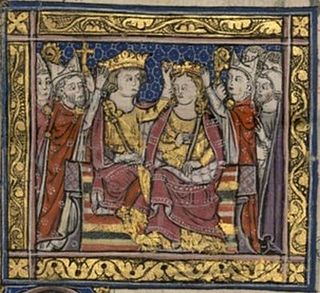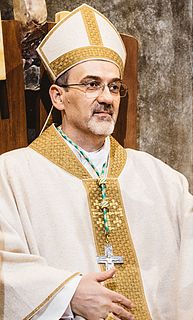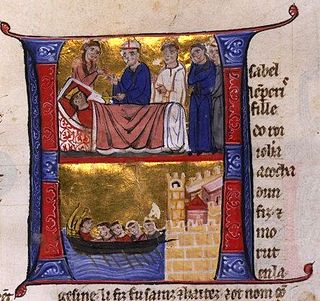Related Research Articles

The Kingdom of Jerusalem, also known as the Latin Kingdom of Jerusalem or the Frankish Kingdom of Jerusalem, was a Crusader state established in the Southern Levant by Godfrey of Bouillon in 1099 after the First Crusade. The kingdom lasted nearly two hundred years, from 1099 until 1291 when its last remaining possession, Acre, was destroyed by the Mamluks. Its history is divided into two distinct periods.

The Sixth Crusade, commonly known as the Crusade of Frederick II (1228–1229), was a military expedition to recapture the city of Jerusalem. It began seven years after the failure of the Fifth Crusade and involved very little actual fighting. The diplomatic maneuvering of the Holy Roman Emperor and King of Sicily, Frederick II, resulted in the Kingdom of Jerusalem regaining some control over Jerusalem for much of the ensuing fifteen years as well as over other areas of the Holy Land.

Frederick II was King of Sicily from 1198, King of Germany from 1212, King of Italy and Holy Roman Emperor from 1220 and King of Jerusalem from 1225. He was the son of emperor Henry VI of the Hohenstaufen dynasty and Queen Constance of Sicily of the Hauteville dynasty.

John of Brienne, also known as John I, was King of Jerusalem from 1210 to 1225 and Latin Emperor of Constantinople from 1229 to 1237. He was the youngest son of Erard II of Brienne, a wealthy nobleman in Champagne. John, originally destined for an ecclesiastical career, became a knight and owned small estates in Champagne around 1200. After the death of his brother, Walter III, he ruled the County of Brienne on behalf of his minor nephew Walter IV.

The Latin Patriarchate of Jerusalem is the Catholic episcopal see of Jerusalem, officially seated in the Church of the Holy Sepulchre. It was originally established in 1099, with the Kingdom of Jerusalem encompassing the territories in the Holy Land newly conquered by the First Crusade. From 1374-1847 it was a titular see, with the patriarchs of Jerusalem being based at the Basilica di San Lorenzo fuori le Mura in Rome. A resident Latin patriarch was re-established in 1847 by Pius IX.

Isabella II, also known as Yolande of Brienne, was a princess of French origin who became monarch of Jerusalem.

Maria of Montferrat (1192–1212) was the queen of Jerusalem from 1205 until her death. Her parents were Isabella I and her second husband, Conrad of Montferrat. Maria succeeded her mother under the regency of her half-uncle John of Ibelin. After him the kingdom was ruled on Maria's behalf by her husband, John of Brienne, whom she married in 1210. She died giving birth to her successor, Isabella II.
Alice of Champagne was the queen consort of Cyprus from 1210 to 1218, regent of Cyprus from 1218 to 1223, and of Jerusalem from 1243 to 1246. She was the eldest daughter of Queen Isabella I of Jerusalem and Count Henry II of Champagne. In 1210, Alice married her step-brother King Hugh I of Cyprus, receiving the County of Jaffa as dowry. After her husband's death in 1218, she assumed the regency for their infant son, King Henry I. In time, she began seeking contacts within her father's counties in France to bolster her claim to Champagne and Brie against her cousin, Theobald IV. However, the kings of France never acknowledged her claim.

Henry I of Cyprus, nicknamed the Fat was King of Cyprus from 1218 to 1253. He was the son of Hugh I of Cyprus and Alice of Champagne. When his father Hugh I died on January 10, 1218, the 8-month-old Henry became king. His mother was the official regent, but handed off the actual governing to her uncle, Philip of Ibelin. When Philip died, the effective regency passed to his brother, John of Ibelin, the Old Lord of Beirut.
Bohemond IV of Antioch, also known as Bohemond the One-Eyed, was Count of Tripoli from 1187 to 1233, and Prince of Antioch from 1201 to 1216 and from 1219 to 1233. He was the younger son of Bohemond III of Antioch. The dying Raymond III of Tripoli offered his county to Bohemond's elder brother, Raymond, but their father sent Bohemond to Tripoli in late 1187. Saladin, the Ayyubid sultan of Egypt and Syria, conquered the county, save for the capital and two fortresses, in summer 1188.

The Crusader state of the Kingdom of Jerusalem, created in 1099, was divided into a number of smaller seigneuries. According to the 13th-century jurist John of Ibelin, the four highest crown vassals in the kingdom proper were the count of Jaffa and Ascalon, the prince of Galilee, the lord of Sidon, and the lord of Oultrejordain.

Hermann von Salza was the fourth Grand Master of the Teutonic Knights, serving from 1210 to 1239. A skilled diplomat with ties to the Holy Roman Emperor and the Pope, Hermann oversaw the expansion of the military order into Prussia.
Raoul of Mérencourt was Latin Patriarch of Jerusalem from 1214 to 1224. He succeeded the assassinated Albert Avogadro.
John of Ibelin, called the Old Lord of Beirut, was a powerful crusader noble in the 13th century, one of the best known representatives of the influential Ibelin family. The son of Balian of Ibelin and the dowager queen Maria Comnena, he had close ties with the nobility of both Cyprus and Jerusalem, since he was the half-brother of Queen Isabella I of Jerusalem. Before he was 20, he was appointed constable of Jerusalem, and a few years later became lord of Beirut, where he rebuilt the city after Saladin's conquest, and established the grand Ibelin family palace. He served as regent for two of his young relatives, Isabella's daughter Maria of Montferrat from 1205 to 1210, and then Henry I of Cyprus from 1228 until Henry came of age in 1232. John was known as a principled man, and was seen as the natural leader of the Christian barons in the Holy Land. He resisted the power-seeking of Frederick II, Holy Roman Emperor, in Cyprus, and opposed the imperial forces until Henry came of age.

Isabella, also Isabel was queen regnant of Armenian Cilicia from 1219 until her death.
The see of Tyre was one of the most ancient dioceses in Christianity. The existence of a Christian community there already in the time of Saint Paul is mentioned in the Acts of the Apostles. Seated at Tyre, which was the capital of the Roman province of Phoenicia Prima, the bishopric was a metropolitan see. Its position was briefly challenged by the see of Berytus in the mid-5th century; but after 480/1 the metropolitan of Tyre established himself as the first (protothronos) of all the metropolitans subject to the Patriarch of Antioch.

Frederick de la Roche was the sixth Latin archbishop of Tyre (1164–1174), chancellor of the kingdom of Jerusalem, and the chief diplomat of King Amalric. He was a Lorrainer, from the town of La Roche, of noble stock.

The Barons' Crusade, also called the Crusade of 1239, was in territorial terms the most successful crusade since the First Crusade. Called by Pope Gregory IX, the Barons' Crusade broadly spanned from 1234-1241 and embodied the highest point of papal endeavor "to make crusading a universal Christian undertaking." Gregory called for a crusade in France, England, and Hungary with different degrees of success. Although the crusaders did not achieve any glorious military victories, they used diplomacy to successfully play the two warring factions of the Muslim Ayyubid dynasty against one another for even more concessions than Frederick II gained during the more well-known Sixth Crusade. For a few years, the Barons' Crusade returned the Kingdom of Jerusalem to its largest size since 1187.

The timeline of the Kingdom of Jerusalem presents important events of the history of the Kingdom of Jerusalem—a crusader state in Palestine—in chronological order. The kingdom was established during the First Crusade. Its first ruler, Godfrey of Bouillon, was not crowned king and swore fealty to the Latin Patriarch of Jerusalem, Daimbert in 1099. Godfrey's brother and successor, Baldwin I, who did not acknowledge the patriarchs' sovereignty, was crowned the first king of Jerusalem in 1100. Baldwin I and his successors captured all towns on the coast with the support of Pisan, Genoese and Venetian fleets and also took control of the caravan routes between Egypt and Syria. The kings regularly administered other crusader states—the Counties of Edessa and Tripoli, and the Principality of Antioch—on behalf of their absent or minor rulers.
Robert of Nantes was the Latin patriarch of Jerusalem from 1240 to 1254.
References
- ↑ Wilhelm Jacobs, Patriarch Gerold von Jerusalem: Ein Beitrag zur Kreuzzugsgeschichte Friedrichs II. (Aachen, 1905), pg. 7.
- ↑ Jacobs, pg. 7.
- ↑ Jacobs, pg. 11.
- ↑ Bernard Hamilton, The Latin Church in the Crusader States (Cambridge University Press, 1980), pg. 256.
- ↑ Hamilton, pg. 258.
- ↑ Hamilton, pg. 258–259.
- ↑ Hamilton, pg. 259.
- ↑ Hamilton, pg. 260.
- ↑ Hamilton, pg. 261.
- ↑ Hamilton, pg. 262.